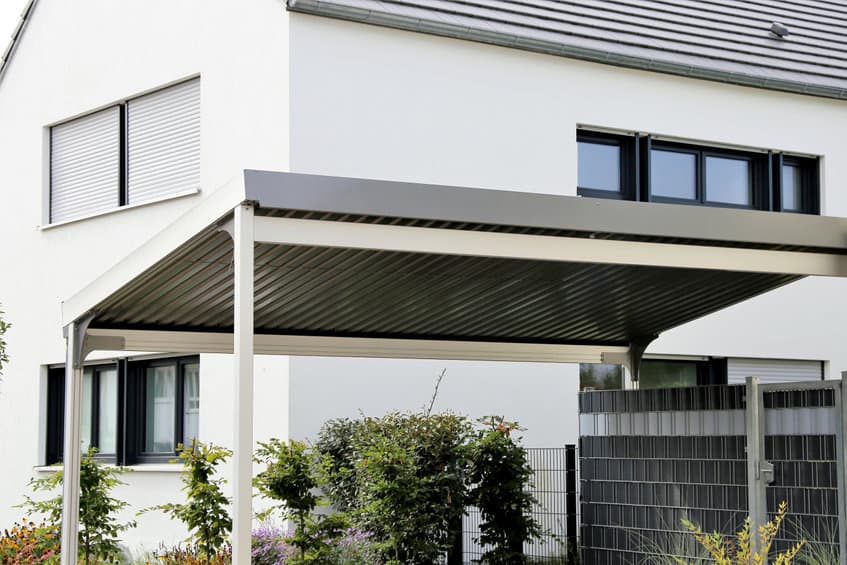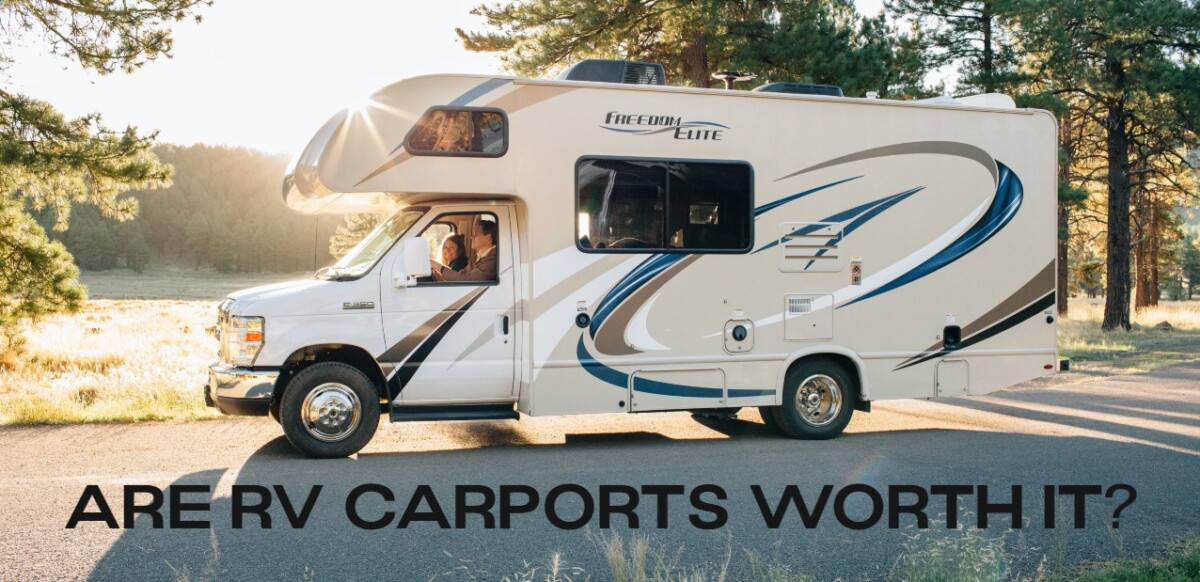Recreational vehicles, as great as they are, come with challenges. They are bulky and have to be stored when not in use.
Paying for rental storage space is expensive and has some risk since it’s not at your home.
An RV carport will keep elements like ice, snow, and rain off your vehicle, so it goes a long way to prevent rust. It also offers some protection from falling tree limbs and harsh sunlight, and would save you money over the long term compared to a rental space. It is worth it for savings over time.
However, many people installing an RV carport make some of the same costly problems. Failing to get proper permitting, not building the structure high enough or big enough for additional uses later, are just a few of the common mistakes.
Sometimes, people build carports in the wrong spot or don’t get a truly secure structure.
Avoiding these problems will help to construct your RV carport a lot easier.
In fact, many of these problems can be avoided with some research and little planning. This is a project to just jump into.
Here is a list of 5 common problems people make when installing an RV carport.
1. Failing to get the right permits.
Every municipality is different and some may require permitting for a metal carport while others may not, and some may require permitting only if the carport is above a certain size.
Some cities may not allow an RV to be parked at home at all unless it is in a true enclosed garage.
That could change your plans altogether. It will also change the expense you will need to put out for construction.

Getting a city of county permit will come with a fee, and that largely depends on the jurisdiction. Most municipalities have an informal process for permitting where you simply make an application, pay the application fee, and that is approved by the code enforcement officer.
The final fee is paid upon approval.
Homeowners associations can be a real pain to deal with on certain issues. Depending on your neighborhood, there could be rules against such structures or having an RV at your home. Be sure to get approval from your homeowner’s association. Many forget about that group and end up with citations and fines.
More than likely, there are rules on how an RV carport should be constructed – the color, the size, and where it can be placed. All of these will be under the covenants you signed when you bought the house.
You likely will need to approach the HOA board before getting permits and moving the project along to see if they will approve it first.
This costs nothing, but will require making an application and attending one or two meetings. It’s best to get their permission before putting any money into the project.
2. Failing to plan your carport before construction.
Picking a spot for your RV carport is probably the most important decision you will make. After all, it will be there for years. You don’t want it to be an eyesore for you or the neighbors, but you also want it to be convenient to pull the RV in and out.
You will need a large, open area that appears to go with your home, so it looks good to those who pass by. The area also needs to be a place where it doesn’t run over any electrical, gas, or water lines and won’t cover the septic tank if you have one.

Be aware of the setback on your property for all your utilities and communications. Those who accidentally build on a setback will be cited by a city or county code enforcement officer and will be forced to move the carport.
Planning includes making sure your carport meets all code enforcement standards.
Just because the city or county approved your application to build a carport for your RV doesn’t mean you can build anything you wish. The code enforcement officer should give you a booklet of rules and regulations about construction when you are approved.
If they don’t, ask for one so you can obey the rules and avoid citations.
All cities want structures to be durable and look good so there are likely rules on the type of materials you can use and how the poles are to be secured. These are all things to pay attention to while building.
3. Failing to check your RV carport plans for proper dimensions or style.
Believe it or not, it is a common mistake for people building RV carports to not build them large enough to fit their RV!
This is particularly true of height but can also be in length and width.
That’s because most people don’t measure their RV before building a carport. If you don’t have an owner’s manual that has the height, width, and length listed, you will need to measure it to make sure your carport is big enough for your vehicle.
How tall should my carport be?
You want your RV carport to be tall and wide enough to have clearance all the way around. After all, you want to avoid biting your lip about possibly hitting a pole every time you pull in.
Most Class B RV’s are between 7 and 9 feet tall, so look for a carport that is at least 12 feet tall to give you lots of clearance. Also, allow about three feet clearance on each side, so you have plenty of room.
You must look at your home design and incorporate the carport’s style to fit it.
A major issue for many people looking at installing a carport is they forget to look at the design of their home and implement it into the carport. This is a key point, especially when you are approaching an HOA or the city about permitting.
Many use metal structures or buildings for carports, but there are other options if you have a house with a certain style. In some cases, a metal structure wouldn’t go with the house and will look like an eyesore.
The carport should at least be the same color as the home but, in some cases, should be made out of the same materials. For instance, a log or wood home should have a carport made of wood. The same would go for a rock-faced or other special designer home.
You can accent your carport with bricks or other decorative features once it’s built that make it resemble your home. It doesn’t have to be an exact replica but should go with the style of your home.
4. Failing to understand the costs and spend wrongly.
Understanding how much a carport will cost can be a difficult subject because you aren’t just paying for materials, but labor also. The cost of labor depends largely on the rates of contractors in your area.
Some people go to extremes in both directions. New RV owners, anxious to get a carport, will find the cheapest one possible, only to realize later it is of poor construction quality. Others who want the best for their property don’t do their due diligence in research to find a good price and overpay.
However, you can always make a good deal, by asking the company you are working with if they have a repossessed or discontinued model. Yes, even carports can be repossessed if they are bought on credit. Going that route can earn you a quality carport at half the price
Research the contractors in your area to get a good estimate on the pricing of installations. Ask them if you can buy the carport separately and have them install it. Some contractors require you to go through them for purchase.
How much does a carport cost?
The average carport, which typically measures 20 by 30 feet, costs between $6,000 and $18,000 depending on the materials used and the style selected.
Some homeowners try to build it piecemeal to save money. That is a mistake.
This is a common problem for many people in a lot of home projects, so it’s not surprising this would be a problem with building a carport as well.
RV owners are trying so hard to save a dime they buy parts for the carport at different locations, negotiating prices down at each. Then, they have to find a contractor to install it.
The problem is: These various parts can make your carport project a ‘Frankenstein type’ of situation and some contractors will refuse to work with piecemeal parts because they just don’t work together.
It’s best to buy your carport as one unit and have a qualified installer put it up unless you are confident you can do it yourself.
5. Failure to consider things like future use and foundations.
RV owners are so excited about buying their vehicle, they don’t consider what the carport can be used for in 20 years when they’ve given up road traveling and sold the RV. That isn’t wise.
You should build a carport that can be transformed into something else as years go on, so you don’t have to eventually tear it down. Carports can be built to be enclosed later or to allow for enough room for extra storage down the line.
You may want to build it in such a way that it can eventually be connected to the house with a door, so you can use it as a garage.
These are things to consider during the initial planning stages of your design.
What kind of foundation should I get?
The foundation should be a part of the initial planning.
Every building, even a carport, should have some type of foundation. It can be gravel or a concrete pad, but you don’t want your RV sitting on the grass or dirt.
First, it can get stuck in the mud if there are serious rains. Second, your grass will die, and it will look unsightly in a short period.
You have to consider other things like water runoff when you look at what foundation to use. Other factors include practicality, looks, and what permitting or the HOA will approve.
Conclusion
Building a carport for your RV sounds like an easy task. It is relatively simple to install once you buy it. However, installing a carport requires as much planning as building an additional room.
It’s best to get all your facts upfront first before launching into the project.
While you are here, make sure you check these other fun reads that we found for you.
Storing Boat in a Carport? – Here’s What You Should Know

